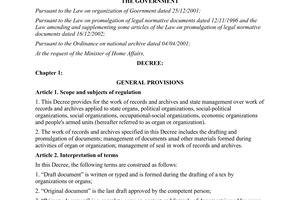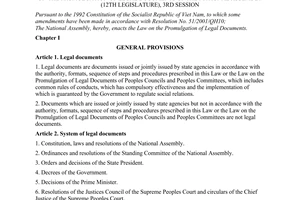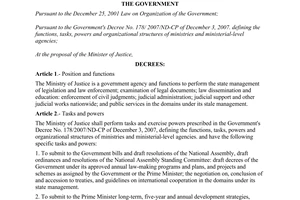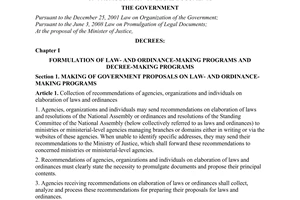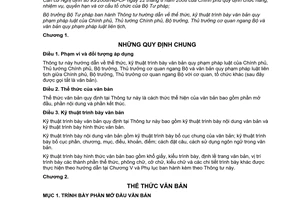Nội dung toàn văn Circular No. 25/2011/TT-BTP on the format of and techniques for presenting legal
|
THE
MINISTRY OF JUSTICE |
THE
SOCIALIST REPUBLIC OF VIETNAM |
|
No. 25/2011/TT-BTP |
Hanoi, December 27, 2011 |
CIRCULAR
ON THE FORMAT OF AND TECHNIQUES FOR PRESENTING LEGAL DOCUMENTS OF THE GOVERNMENT, THE PRIME MINISTER, MINISTERS AND HEADS OF MINISTERIAL-LEVEL AGENCIES AND JOINT LEGAL DOCUMENTS
Pursuant to the 2008 Law on Promulgation of Legal Documents;
Pursuant to the Government s Decree No. 24/2009/ND-CP of March 5, 2009, detailing and providing measures for the implementation of the Law on Promulgation of Legal Documents
Pursuant to the Government's Decree No. 93/2008/ND-CP of August 22, 2008, defining the functions, tasks, powers and organizational structure of the Ministry of Justice;
The Minister of Justice guides the format of and techniques for presenting legal documents of the Government, the Prime Minister, ministers and heads of ministerial-level agencies and joint legal documents.
Chapter I
GENERAL PROVISIONS
Article 1. Scope of regulation and subjects of application
This Circular guides the format of and techniques for presenting legal documents of the Government, the Prime Minister, ministers and heads of ministerial-level agencies and legal documents jointly promulgated by the Government, ministers or heads of ministerial-level agencies and other agencies or organizations (below referred to as documents).
Article 2. Formal of documents
The format of a document under this Circular is the form of presentation of the document, consisting of the beginning part, content part and ending part.
Article 3. Techniques for presenting documents
Techniques for presenting a document under this Circular include techniques for presenting the content and techniques for presenting the form of that document.
Techniques for presenting the content of a document include techniques for presenting the general structure of the document; techniques for presenting structures of a part, chapter, section, article, clause and point; and ways to make sentences and use language in the document.
Techniques for presenting the form of a document covering paper size, presentation style, margining of pages; positions for presenting format components, font type, font size, font style and other presentation details comply with Chapter V and an Appendix to this Circular (not printed herein).
Chapter II
DOCUMENT FORMAT
Section 1: PRESENTATION OF THE BEGINNING PART OF A DOCUMENT
Article 4. The beginning part of a document
1. The beginning part of a document includes the national name, the promulgating agency's name, number and code of the document, place and date of promulgation, document title and promulgation grounds.
2. The beginning part of a document promulgated together with another document such as regulation, rule, charter, list or another similar document includes the national name, the promulgating agency's name and document title below which arc the title, number and code and date of the promulgating document.
Article 5. National name and official motto
1. The national name is 'THE SOCIALIST REPUBLIC OF VIETNAM," which shall be presented in 12 or 13 point upright and bold capital letters at the top right of the first page of the document.
2. The official motto is Independence -Freedom - Happiness." which shall be presented right below the national name in 13 or 14 point upright and bold lowercase letters. The first letter of each word of the official motto is capitalized and the words of the official motto are separated by a dash with a space preceding and following this dash. Under the motto is an uninterrupted line of the same length of the motto's.
Article 6. Names of document promulgating agencies
1. The name of an agency promulgating a document is the name of the agency competent to promulgate that document under law. This name must be the official one and fully written.
2. The name of a document promulgating agency shall be presented in 13 point upright and bold capital letters under which is a proportionally placed uninterrupted line one-third or half of the length of the line of the name.
Article 7. Numbers and codes of documents
1. The number and code of a document include the serial number, year of promulgation and type of the document, and its promulgating agency.
2. The number of a document shall be presented in Arabic numerals, comprising the serial number assigned by the promulgating agency by document type in a year and the year of promulgating that document, starting from number 01 and from January 01 to December 31. The year of promulgation shall be presented with full digits.
3. The code of a document includes abbreviations of the document type and the promulgating agency's name or the state title of the person competent to promulgate that document.
Abbreviation of a promulgating agency's name shall be specifically provided, ensuring shortness, understandability and compliance with regulations.
4. The number and code of a document shall be presented as follows:
a/ The number and code of a document shall be presented in the following order: serial number of document/year of promulgation/ abbreviation of document type-abbreviation of promulgating agency's name (without any space between them);
b/ The number and code of a document shall be left centered below the promulgating agency's or organization's name;
c/ The word "number'' shall be presented in 13 point upright lowercase letters followed by a colon. A number smaller than 10 shall be preceded by the numeral 0;
d/ The document code shall be presented in 13 point upright lowercase letters;
e/ The serial number, year of promulgation and code of a document shall be separated by slashes (/). Abbreviations in the document code shall be separated by dashes (-) without any space.
Article 8. Places and dales of document promulgation
1. The place written in a document is the official name of the province or centrally run city in which the promulgating agency is headquartered.
2. The date of promulgation of a document is the date on which the document is signed for promulgation or certification. The date, month and year of promulgating the document shall be fully written in Arabic numerals. A number showing a date smaller than 10 or showing January or February shall be preceded by the numeral 0.
3. The place and date of promulgation shall be presented in the same line, with the document number and type in 13 or 14 point italic lowercase letters. The first letter of each word of the place shall be capitalized; the place is followed by a comma: the place and date of promulgation shall be left centered below the national name and official motto.
Article 9. Titles of documents
1. The title of a document consists of the document type name and the document name.
2. The document type name is the name of each type of documents defined under the Law on Promulgation of Legal Documents.
3. The document name is a short sentence or a phrase summarizing the document's main content.
4. The document title shall be presented as follows:
a/ The document type name shall be presented in 14 point upright and bold capital letters and left centered.
b/ The document name shall be presented right below the document type name in 14 point upright and bold lowercase letters and left centered;
c/ For a document promulgated together with another document, the note on the promulgation of that document shall be presented right below the document title in 14 point italic letters in brackets and left centered.
Article 10. Promulgation grounds
1. A ground for promulgating a document is a legal document of higher legal effect which is currently in effect or which has been announced or signed for promulgation but is not yet in effect and will take effect at the same time of or earlier than the promulgated document.
2. In case a legal document of higher legal effect contains an article or a clause authorizing its detailing, the detailing document must specifically invoke that article or clause in the section on promulgation grounds.
A detailing document which details both assigned articles and clauses and other contents is not required to specify such articles and clauses in the section on promulgation grounds.
3. Promulgation grounds of a document shall be presented in 14 point italic lowercase letters right below the document title. Each promulgation ground shall be presented in a separate line ended with a semicolon except the line of the last promulgation ground which shall be ended with a period.
Section 2: PRESENTATION OF THE CONTENT PART OF A DOCUMENT
Article 11. Document structure
1. Depending on its scope of regulation, a document may be presented in:
a/ Parts, chapters, sections, articles, clauses and points:
b/ Chapters, sections, articles, clauses and points;
c/ Sections, articles, clauses and points;
d/ Articles, clauses and points; or
e/ Clauses and points.
2. A part, chapter, section or article of a document must have a title which is a phrase showing the main content of that part, chapter, section or article.
3. A document shall be presented as follows:
a/ The content (body text) shall be justified in 13 or 14 point upright lowercase letters; the first line of each paragraph may indented 1 cm to 1.27 cm (1 default tab); the spacing between paragraphs must be at least 6 points; lines shall be presented at least in single line spacing or at least 15 point spacing (exactly line spacing).
b/ A document containing parts, chapters, sections, articles, clauses and points shall be presented as follows:
The word "Part" or "Chapter" and its serial number shall be placed in a separate line, centered and presented in 13 or 14 point upright and bold lowercase letters. The serial number of a part or chapter shall be presented in Roman numerals. The part or chapter title shall be presented right below, centered in 13 or 14 point upright and bold capital letters;
The word "Section" and its serial number shall be placed in a separate line, centered and presented in 13 or 14 point upright and bold lowercase letters. The serial number of a section shall be presented in Arabic numerals. The section title shall be presented right below, centered in 12 or 13 point upright and bold capital letters;
The word "Article" and its serial number and title shall be presented in upright lowercase letters 1 default tab from the left margin of the page. The serial number of an article shall be presented in Arabic numerals followed by a dot. An article shall be presented in bold and upright letters of the same font size as that of the body text (13 or 14);
The serial numbers of clauses of a section shall be presented in Arabic numerals followed by a dot. The serial number of a clause shall be presented in upright letters of the same font size as that of the body text (13 or 14). A clause with a title shall have its serial number and title presented in a separate line and in upright lowercase letters of the same font size as that of the body text (13 or 14).
Points of a clause shall be placed in the order of the Vietnamese alphabet, followed by a closing bracket and presented in upright lowercase letters of the same font size as that of the body text (13 or 14).
Article 12. Documents promulgating other documents
A document promulgating another document consists of two parts: promulgating document and promulgated document.
The promulgating document contains provisions on the promulgation of the other document, organization of implementation and effect of the document.
The promulgated document contains specific provisions of the document. Depending on its content, the promulgated document may be presented in parts, chapters, sections, articles, clauses and points.
Section 3: PRESENTATION OF THE ENDING PART OF A DOCUMENT
Article 13. Presentation of the ending part of a document
The ending part of a document includes the competent signee's position, full name and signature; the promulgating agency's seal; and recipients of the document.
The ending part of a document promulgated together with another document includes the competent signee's position, full name and signature; and the promulgating agency's seal.
Article 14. Presentation of signatures
1. For a decree of the Government, the Prime Minister shall sign to promulgate the decree on behalf of the Government and the abbreviation "TM"' (on behalf of) must precede the word "the Government''.
For a decision of the Prime Minister, a circular of a minister or head of a ministerial-level agency, the Prime Minister, minister or head of ministerial-level agency shall sign to promulgate the document.
In case a deputy signs the document on behalf of the competent signee, the abbreviation "KT" (sign on behalf of) must precede the position of the competent signee.
2. The position and full name of the competent signee or the person signing on behalf of the former shall be fully indicated in the document.
For a joint document, the positions and agency names of the signees shall be fully written.
3. The abbreviation "TM," "KT," or "Q" (acting), authorization and position of the signee shall be presented in 13 or 14 point upright and bold capital letters.
The signee's full name shall be presented in 13 or 14 point upright and bold lowercase letters and left centered below the line of authorization and position of the signee.
Article 15. Seals of promulgating agencies
1. A promulgating agency's seal may only be appended on a document after it. is signed by a competent person.
2. Seals shall be appended on documents under Clauses 2 and 3, Article 26 of the Government's Decree No. 110/2004/ND-CP of April 8. 2004. on clerical work, and related laws; seals shall be appended on every two adjoining pages of documents and their appendices under Clause 4, Article 26 of Decree No. 110/2004/ND-CP.
Marks of confidentiality (extremely confidential, strictly confidential or confidential) on documents of slate secret comply with the law on state secret protection.
Article 16. Recipients
1. Recipients of a document include the supervising agency, examining agency, promulgating agency, CONG BAO (official gazette) office, archiving agency and other agencies and organizations depending on the document content.
2. The word '"recipients" shall be presented separately (in the same line with the phrase "authorization and position of signee" and at the left margin) in 12 point italic and bold lowercase letters, ended with a colon;
Recipients of the document shall be presented in 11 point upright lowercase letters: the name of each recipient or group of recipients shall be presented in a separate line started with a dash at the left margin and ended with a semicolon; in the last line is the word "file" followed by a colon and the abbreviation VT (clerical section of the agency or organization), abbreviation of the name of the unit (or section) drafting the document and the number of copies for file (only when necessary) placed in brackets and ended with a period.
Chapter III
TECHNIQUES FOR PRESENTING DOCUMENT CONTENT
Article 17. Presentation of the structure of a document
1. The arrangement of provisions on the same issue in a part, chapter or section must adhere to the following principles:
a/ General provisions precede specific provisions;
b/ Substantive provisions precede procedural provisions;
c/ Provisions on rights and obligations precede provisions on sanction;
d/ Universal provisions precede particular provisions;
c/ Provisions on general cases precede provisions on exceptional cases;
2. A document's structure shall be presented according to the following principles:
a/ Part is the largest structural unit of a document. Parts of a document arc independent from one another;
b/ Chapter is the second largest structural unit of a document. Chapters of a document are relatively independent and arranged in a systematic and logical manner;
c/ Section is the third largest structural unit of a document. Sections are divided in a relatively independent, systematic and logical manner. Sections may be used in chapters containing many provisions and articles;
d/ Articles may be presented in clauses and points. Each article shall be presented in full, complete and grammatically correct sentences;
e/ Clauses are used when an article contains relatively independent ideas. Each clause shows a complete idea and shall be presented in complete sentences;
f/ Points are used when an article or a clause contains different ideas.
Article 18. Use of language in documents
1. The language used in documents is universal Vietnamese.
2. Dialectal, archaic, colloquial and foreign words may not be used.
When a substituting Vietnamese term is unavailable, a foreign word may be used if it belongs to a popular or universal language or it is transcribed into Vietnamese.
Article 19. Proper use of words
1. A document must use written language with clear, simple and understandable expression.
2. A document containing a technical term which requires clarification must explain that term.
3. An abbreviation may only be used when necessary and explanation about that abbreviation is required at its first appearance.
A document containing many abbreviations must have a separate article explaining all abbreviations used in that document.
Article 20. Use of words with proper meaning
1. Words used in a document must accurately demonstrate ideas to be conveyed without leading to different interpretations. When a word may lead to different interpretations, its intended meaning must be explained in the document.
2. Interrogative words and rhetoric expressions may not be used in a document.
3. Words must be used consistently in a document.
Article 21. Sentences in documents
1. A sentence must have a full content and complete form and ensure connection between its parts.
2. Normative provisions must directly rather than generally provide contents to be governed and be presented concisely, clearly and accurately.
3. A sentence must be concise and clear without redundant words.
4. Interrogative and exclamatory sentences may not be used in a document.
Article 22. Punctuation in documents
Punctuation in a document must follow Vietnamese grammatical principles. Question and exclamation marks and ellipses may not be used in a document.
Article 23. Presentation of figures in documents
1. Figures in a document shall be presented in Arabic numerals then written out in words, except the cases specified in Clause 2 of this Article.
2. Figures in the beginning and ending parts of a document; figures expressing the length of time, point of time and quantity of units of measurement shall be presented in Arabic numerals.
Article 24. Presentation of units of measurement
Units of measurement in a document shall be presented in words followed by their symbols which are put in brackets. Names and symbols of units of measurement shall be presented uniformly under regulations on measurement.
Article 25. Presentation of lime limits and points of lime
1. Time limits which are determined in minutes, hours, days, weeks, months, quarters and years shall be presented in numbers expressing the length of time and units of time.
2. Points of time which are determined in minutes, hours, days, weeks, months, quarters and years shall be presented in numbers expressing the point of time and units of point of time.
3. Units of time or units of point of time shall be presented in words following the numbers expressing the length of lime or point, of time.
Article 26. Presentation of amended and supplemented contents in the chapter or article on implementation provisions
1. A document which amends and supplements a part, chapter, section, article, clause, point or phrase of another document must provide such amendments and supplements in the chapter or article on implementation provisions. These amendments and supplements may be presented in articles, clauses and points depending on their scope and levels.
2. The amendments and supplements must specify the part, chapter, section, article, clause or point of the amended document.
Article 27. Presentation of transitional provisions
1. Transitional provisions of a document are used to handle legal relations existing before the promulgation of that document when it is difficult lo immediately apply provisions of that document to those legal relations.
Transitional provisions must aim to protect citizens' fundamental rights; and harmonize interests of people and the Slate.
2. Transitional provisions shall be provided in a separate article in the ending part of a document named "transitional "provisions" or right in articles or clauses requiring transitional provisions.
Article 28. Presentation of effect of documents
1. A document must specify the point of time of its effect.
2. The article on the effect of a document must specify the title of a document, or a part, chapter, section, article, clause or point of a document to be annulled. When many documents or articles, clauses and points of document are annulled under a document, that document must be attached with a list of annulled documents and provisions.
Article 29. Techniques for invoking documents
1. A document invoking another document must fully indicate the latter's title, serial number and code and promulgating agency.
2. A document invoking a part, chapter or section of another document must specify that part, chapter or section.
3. A document invoking an article, clause or point of another document is not required to specify the part, chapter and section containing that article, clause or point.
4. A document invoking a part, chapter, section, article, clause and point of another document must invoke them in the order from small to large structural units, including the document title. When invoking from a clause or point to another clause or point of the same article, or from a section or an article to another section or article of the same chapter of the same document, the document title is not required to be specified.
Chapter IV
PRESENTATION OF AMENDING AND SUPPLEMENTING DOCUMENTS
Section 1: PRESENTATION OF DOCUMENTS AMENDING AND SUPPLEMENTING A NUMBER OF ARTICLES
Article 30. Documents amending and supplementing a number of articles
1. A document amending and supplementing a number of articles means a document amending, supplementing, annulling or replacing one or a number of provisions of an existing document.
2. A document amending and supplementing a number of articles must specify the chapters, sections, articles, clauses and points of the document to be amended, supplemented, annulled or replaced.
Article 31. Title of a document amending and supplementing a number of articles
The title of a document amending and supplementing a number of articles comprises that document's type name together with the phrase "amending and supplementing a number of articles of and the full title of the revised document.
Article 32. Structure of a document amending and supplementing a number of articles
1. A document amending and supplementing a number of articles of another document may comprise 4 articles: Article 1 provides amendments and supplements; Article 2 provides the annulment or replacement of words or expressions related to many articles and clauses of the revised document; Article 3 provides implementation responsibilities (if any); and Article 4 provides the document's effective dale.
2. Clauses on amendments, supplements, annulment or replacement shall be arranged in the order corresponding to the order of articles and clauses of the revised, document.
Article 33. Numbering of supplemented articles and clauses
Articles and clauses supplemented shall be numbered as follows:
1. Based on contents to be supplemented, to determine the positions of articles and clauses to be supplemented to an existing document;
2. To number these articles and clauses by adding a letter in the order of the Vietnamese alphabet to the number of the preceding article or clause.
3. The serial number of a chapter, section, article or clause lo be supplemented consists of a number and a letter. The number is the serial number of the chapter, section, article or clause of the revised document. The letter is arranged in the order of the Vietnamese alphabet.
The serial number of a point to be supplemented consists of a number and a letter. The letter is presented in the order of the points of the revised document. The number starts from 1.
Article 34. Sequence of articles and clauses of a revised document
The presentation of a document amending and supplementing a number of articles must not cause changes in the sequence of the revised document's articles and clauses which are not amended, supplemented, annulled or replaced.
Section 2: PRESENTATION OF DOCUMENTS AMENDING AND SUPPLEMENTING MORE THAN ONE DOCUMENT
Article 35. Documents amending and supplementing more than one document
A document amending and supplementing more than one document means a document amending, supplementing, annulling or replacing provisions of a number of related documents.
Article 36. Title of a document amending and supplementing more than one document
Depending on its amendments and supplements, the title a document amending and supplementing more than one document may consist of that document's type name together with the phrase "amending and supplementing a number of articles of and the name of a revised document with generalized revised provisions or the names of all revised documents.
Article 37. Structure of a document amending and supplementing more than one document
1. Depending on its content, a document amending and supplementing more than one document may be presented in separate articles each of which contains amendments and supplements to a document, except the article on implementation responsibilities/organization of implementation/effect of the amending and supplementing document.
2. Articles and clauses of the amending and supplementing document must specify the titles, articles, clauses and points of the revised documents.
The title of an article of the amending and supplementing document is the order guiding the amendment, supplementation, annulment or replacement of each specific document.
3. Articles of a document amending and supplementing more than one document may be presented in clauses; clauses may be presented in points.
4. A clause comprises an order guiding the amendment, supplementation, annulment or replacement of a chapter, section, article, clause or point, and the content of such revision.
5. Amendments, supplements and annulment and replacement provisions shall be provided in the order corresponding lo the sequence of articles and clauses of the revised documents.
Chapter V
PAPER SIZES, MARGINS, FONTS AND PAGE NUMBERING OF DOCUMENTS
Article 38. Paper sizes
The original of a document shall be presented in A4-size paper with a width of 210 millimeters (mm) and a height of 297 millimeters (mm). These sizes may have an error of 0.2 millimeter (mm).
Article 39. Margins of pages of documents
1. A page of a document has the following margins:
a/ Top margin: 20 millimeters (mm); b/ Bottom margin: 20 millimeters (mm); c/ Left margin: 30 millimeters (mm); d/ Right margin: 20 millimeters (mm).
2. The sizes specified in Clause 1 of this Article may have an error of 5 millimeters (mm).
Article 40. Fonts
Fonts of a documents must be under the Vietnamese character code (Vietnamese font Unicode) according to Vietnamese standard TCVN6909:2001.
Article 41. Page numbering of documents
Pages of a multi-page document shall be numbered in Arabic numerals consecutively from the second page to the last page of the document horizontally in the center in the top margin or at the right in the bottom margin of the document.
Chapter VI
IMPLEMENTATION PROVISIONS
Article 42. Annulment of current regulations
Provisions under this Circular replace provisions on the format of and techniques for presenting legal documents of the Government, the Prime Minister, ministers, heads of ministerial-level agencies and joint legal documents under Joint Circular No. 55/2005/ TTLT-BNV-VPCP of the Ministry of Home Affairs and the Government Office of May 6, 2005, guiding the formal of and techniques for presenting documents.
Article 43. Effect
This Circular takes effect on March 1, 2012.
Article 44. Organization of implementation
Ministries and ministerial-level agencies shall implement this Circular. -
|
|
MINISTER
OF JUSTICE |
